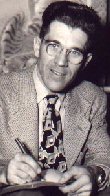 Athlete. For years Nebraska high school milers ran in the footsteps of this famous track star. Gil Dodds was graduated from Falls City High School in 1937. In his final spring he ran a mile in a record time of 4:28.1. The state record time lasted until well after World War II. He never lost a race in high school competition, winning the mile at the boys state track meet his sophomore, junior and senior years. Later, he became nationally known as a runner and in 1948 when he was 29 years old set a blazing pace, winning an indoor race in Madison Square Garden in 4:05.3, then a record time.
Athlete. For years Nebraska high school milers ran in the footsteps of this famous track star. Gil Dodds was graduated from Falls City High School in 1937. In his final spring he ran a mile in a record time of 4:28.1. The state record time lasted until well after World War II. He never lost a race in high school competition, winning the mile at the boys state track meet his sophomore, junior and senior years. Later, he became nationally known as a runner and in 1948 when he was 29 years old set a blazing pace, winning an indoor race in Madison Square Garden in 4:05.3, then a record time.
Dodds ran at Ashland (Ohio) College and became known world wide while running for the Boston Athletic Club, setting the world indoor mile record three different times and winning the Sullivan Award in 1943 as the nation’s outstanding amateur athlete.
There was an amusing article in the newspapers sometime back. It was about America’s premier mile runner of the 1940s, Gil Dodds. Dodds was known as “The Flying Parson” because he was an ordained minister. Dodds usually signed autographs along with a scripture reference. This was his way of setting an example. Not all of his fans knew what the notations meant, though. When he wrote “Phil. 4:13” as a shortened form of Philippians 4:13, one fan thought that was Dodds’ phone number. Another mistook it for Dodds’ performance in a race at Philadelphia. Dodds spent one summer running against Swedish great Gunder Hagg, and the promoters switched distances. They were supposed to run one mile. They ended up running two. So Dodds accompanied his autograph with “Matthew 5:43,” which reads: “Whoever shall compel you to go a mile, go with him two.”
Key Bible Verse: Let us strip off every weight that slows us down, especially the sin that so easily hinders our progress (Hebrews 12:1). Bonus Reading: Hebrews 12:1–4
Runner Gil Dodds was once preparing for a race. After a series of stretching exercises, Dodds ran several warmup laps around the track. Just before the race began, he quickly changed into some other track shoes. One of the onlookers asked why he was changing shoes. Dodds tossed to the inquirer one of his warmup shoes. Then one of his racing shoes.
The man was still puzzled. There was no detectable difference in the two shoes. Both looked the same. Both seemed to weigh the same. Dodds explained. There was indeed a difference. The warmup shoes were slightly heavier than his racing shoes. Though only a small difference, saving even that much weight for the race could spell the difference between victory and defeat.

